Myanmar (Burma)
Copyright 2011, all rights reserved, by Bob Frazee
[Tools for the well heeled traveler.]
[Yayok Pyl Paya Stupa]
[Nanda Pyin Na Stupa and Monestary]
[Thanaka Cosmetics]
[The Open Market]
[Shwezigon (Golden) Pagoda]
[Ananda Temple]
[Eclipse of the sun]
[Lacquarware Factory]
[Sulamani Pagoda & Sundown]

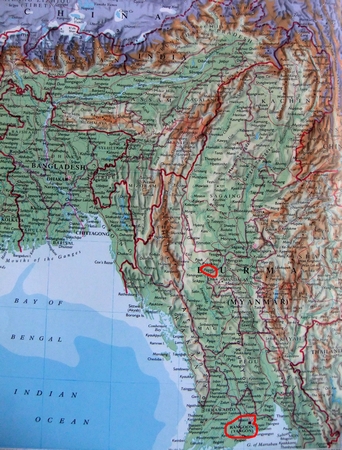
Map of Myanmar (Burma) showing location |

Aung San Suu Kyi was the leader of the |
Pagan (original name) lies on the Ayeyarwaddy River, which is referred to as "The Road to Mandalay". Pagan is called the "City of a Million Pagodas." The Pagodas, Stupas, and/or Temples date back more than 1500 years. The majority of them built in the 11th to 13th century at which time Bagan was the capital of the Myanmar dynasty.
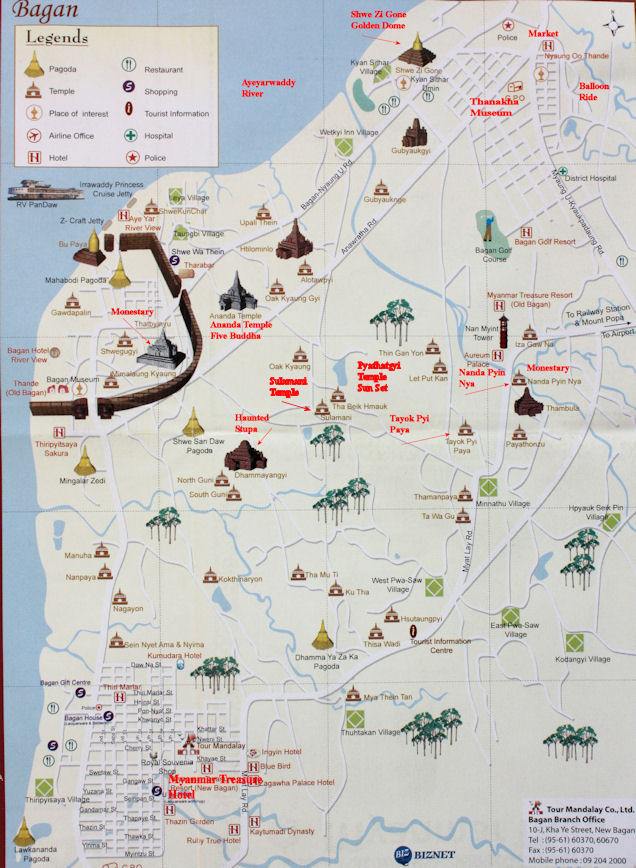

01. We drove wide eyed past many Stupas as we left the airport |
02. Tayok Pyi Paya Stupa. We were about to enter a whole new world of religious thought. Buddhism and Hinduism were both imported from India and exist side by side, carving next to carving and wall painting next to wall painting. To the people of southeast Asia there is nothing inconsistent with state of affairs. |
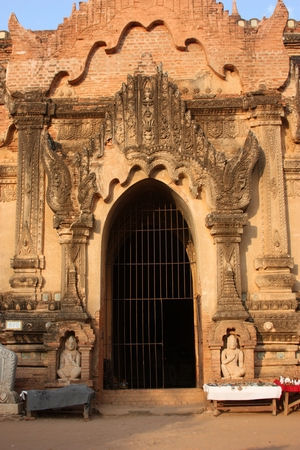 03. Gate to enter Stupa - But first, we must take off our shoes |
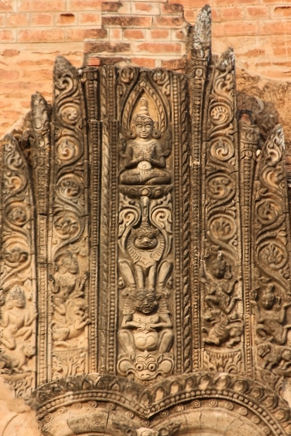 04. Note the figures in middle column of carvings Top to bottom: Bodi Satta (a Buddha to be) Lion Oger - big teeth, eats meat (men) |
05. But first we walk past many booths filled with treasures to adorn our homes upon our return. |
06. So much to entice us, but we are only in the second day of our journey to Burma |
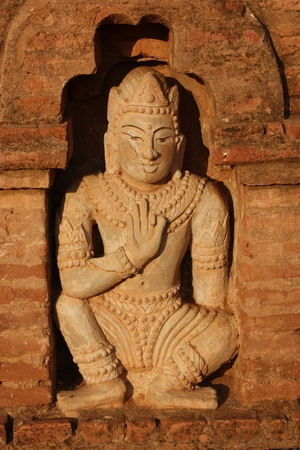 07. Reliefs of Buddha everywhere |
08. The Stupa is a solid construction to hold relics and remains but alcoves all around the structure have statues of Buddha |
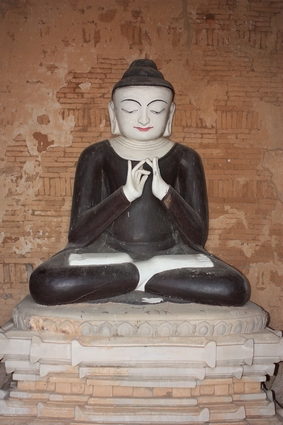 09. Every statue of Buddha has a meaning. |
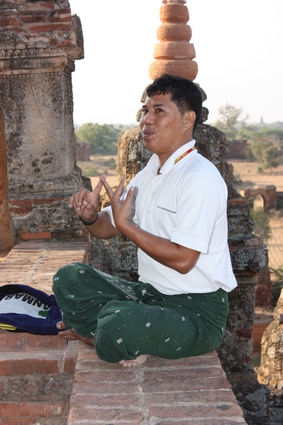 10. The way Buddha holds his hands tells the faithful what he is preaching. "Reasoning and Instruction" Our guide explains each one. |
11. Walking through the corridors that surround the Stupa we see many painting of Buddha - here teaching. |
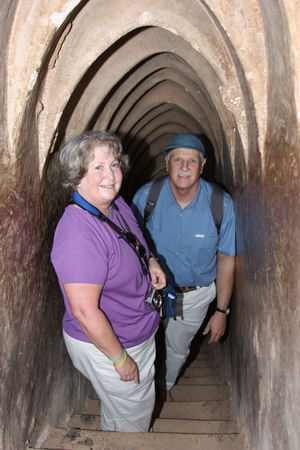 12. We climb a very narrow and steep staircase, obviously made for shorter people, to get to the viewing area on the roof. |
13. The view from the roof allows us to marvel at how extensive Stupas cover the landscape |
14. This is the dry season and the shepherds graze their sheep in the fields which are covered by gain during the wet season. |
15. Stupas are seen in the horizon in all directions. |
In Buddhism the concept of Making Merit is very important. Merit accumulates as a result of good deeds, acts or thoughts and that carries over to later in life or to a person's next life. Such merit contributes to a person's growth towards liberation and thus building a Stupa to venerate Buddha would be one good deed and a way to earn merit.
From the balcony there were at least thousands, if not a million, Stupas in sight. Many of them were damaged and some had been repaired. Like the Egyptian monuments there were a vestige of days gone by. I understand that the UNESCO has denied Bagan the designation of a World Heritage Site because too many of the repairs were done in a haphazard fashion. That too bad - I think the UN got it wrong again.
16. |
17. |
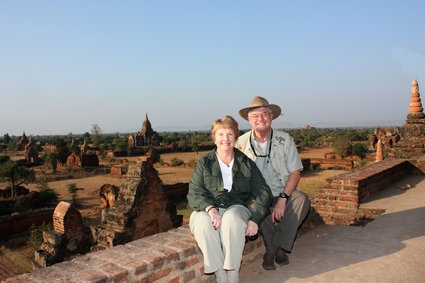 18. |
19. |
20. Two bodied Lions often served to decorate corners. |
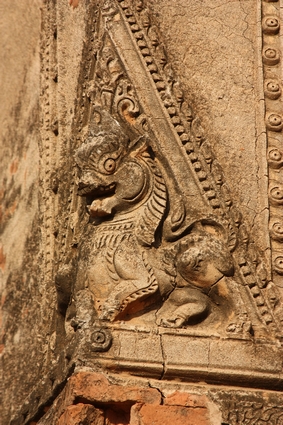 21. The Burmese had never seen a lion so they carved it from literary descriptions |
22. Man eating Ogres are a favorate subject. |
23. |
24. Buddhist art - colored sand glued on cloth. Each one done by hand; no two alike. |
25. These are easy to carry because they can be rolled up tight and packed in a suitcase. |
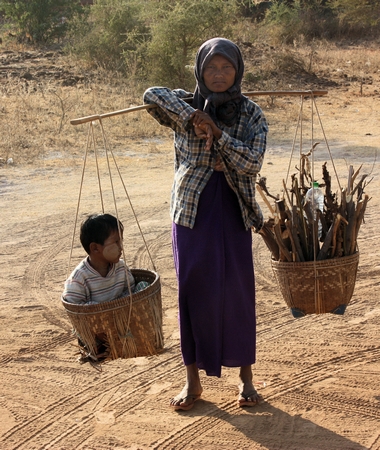 26. Woman hunting for wood balances the weight with child. |
27. It doesn't take long to gather a crowd. |
28. Ornate doorway. |
29. We can't resist, Dancing Lord Shiva (Hindu god) now adorns our sun room. |
Here we saw the old world and new world combined. Travel by horse and buggy, a favorite for the Amish in Iowa, was a common method of transportation in Myanmar. Our modern air conditioned bus , parked in front of the stupa, stands in stark contrast to the horse cart of the farmer selecting stones for a building project of some kind.
You can read more about it at Wikipedia
After we visited the Tayok Pyi Papa Stupa we rode a short distance to our second wonder, Nanda Pyin Na Stupa.
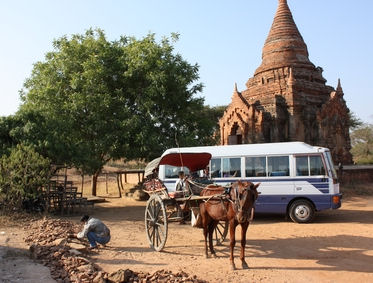
30.
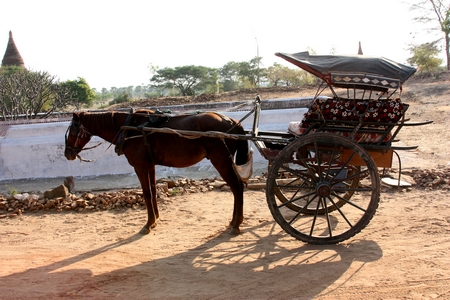
31.
At this location it was not the stupa but rather the Kyat Kan Umin (cave) a monetary cave dug into the ground. A large area of stone was dug out in the shape of a rectangle with buildings in the middle and then caves for the monks dug into the perimeter walls. The area was very tightly built so photographs didn't show much. We were not allowed to enter into the facility so my pictures are limited. I regret not spending more time trying to get better perspectives.
32.
33. Entrances to the caves.
As we left the site we drove past this more traditional golden pagoda. As I may have mentioned before, the stupas dot the countryside and the farmers grow their cops around the temples which appear to be haphazardly constructed without any central zoning ordinances. At one time large mansions may have stood along the wide boulevards which are now used to transport crops to market.
34. A standard looking pagoda
35.Large stupas dot the countryside
Because we are traveling during the "dry" the crops have been picked the the fields prepared for next year's crops. Our day was just beginning -- we had taken a 6 a.m. flight from Yangon to Bagan (a 30 minute flight) and the stupas we visited weren't 15 minutes from the airport. It was only about 9:30 a.m. when we left this area and headed for the old city of Bagan.

![]()
On our way to Old Bagan Open Market
36.Burmese have the most beautiful alphabet.
37. Trucks look like they are left over from WWII
38. Motorbikes are the most common form
of family transportion.
39.Horse carts are common as well

![]()
Thanakha Cosmetics
One thing we noticed when we arrived in Myanmar is that the women, and sometimes children, had their cheeks, and sometimes other parts of their faces, painted. This was not occasional, but everywhere throughout the country. It is worn by babies, children, little girls, teenage girls, and women but not men.
40 Child painted with Thanakha
to protect against the sun.
41. Teenage girl. It is also
suppose to keep the skin soft.
42. Mother with her baby and child.
43. Young girlThanakha appears to be used most as a form of cosmetic. Lennie, our OAT guide, told us it was used to protect the face from the sun. Although this may be true for small children I am convinced that eventually it becomes a form of rouge and perfume used by women to decorate their cheeks. Look at my pictures you can draw your own conclusions.

![]()
The Open Market
44. Woman in market.
45. Woman selling Thanakha logs.You will see Thanakha worn everywhere on women. It is not something sold by Avon, Estee Lauder, Elizabeth Arden, Gucci, or Johnson and Johnson. It is a home-made cosmetic made by rubbing the bark of a Thanakha log on a circular stone slab (kyauk pyin) upon which has been placed a small amount of water.
At the market you will find women selling small logs with bark from the tree. Thanakha cream has been used by Burmese women for over 2000 years and has a fragrant scent somewhat similar to sandalwood. The paste can be applied to the face in attractive designs, the most common form being a circular patch on each cheek or sometimes patterned in the shape of a leaf. It often is used to highlighting the bridge of the nose.Nyang-U
The Local Farmer's MarketLocal farmer's markets are my favorite locations. So much going on - while people are selling their crops they are visiting and showing off their children. Here is where you see people in their natural setting. Color is everywhere and we get to see people doing an everyday activity of life. I find that I get better pictures using a long telephoto lens than by sticking a camera in their face.
46. Fresh vegetables brought in daily
47. Look at the size of those vegetables
48.
49.
50. Carrying baskets of food on your
head seems so practical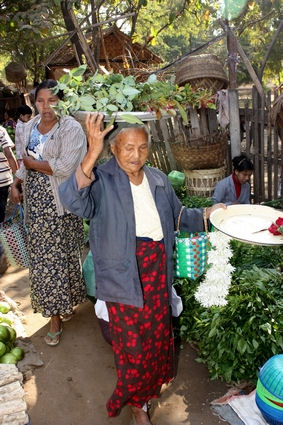
51. Anything can be carried this way.
52.
53. You can see our group file through the
narrow aisles between the rows of vegetables.
I always "hang back" because it gave the people
a chance to resume their normal activities after
the tourists had gone through.
54. >
55.
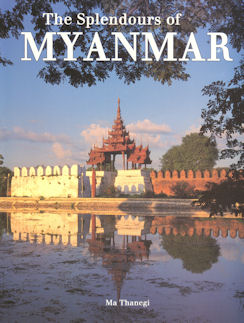
Travel books on Myanmar are difficult to
find but this one I got at the Museum in
Yangon. I liked it because it was mostly
pictures which shows what we have seen and some-
times, but not often, I need to use its
pictures to show something we had seen.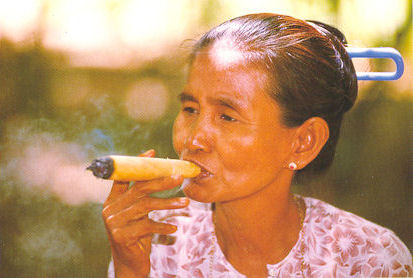
The book had this picture in the section on Bagan and described
her as a "country" woman smoking a cigar made of a "few cornhusks and
chopped tobacco mixed with fragrant leaves and a bit of palm
sugar". Sometimes I have to use these pictures to better describe
what we have seen.
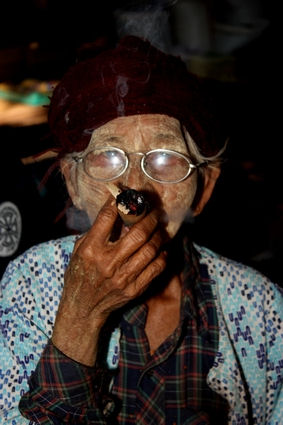
57. I found tis old woman in the market
smoking such a cigar as described above.
She insisted I take her picture and made a point
of blowing smoke into my camera. Unfortunately
I couldn't get her to give me a profile view.
56. Note the scales used to weigh the vegetables.The woman smoking the cigar saw me taking pictures and followed me around to get her's taken. I couldn't get her to turn for a profile photo. I am sure she thought it was a better picture with her blowing smoke in my face. I now feel guilty in not offering her some coins for allowing me to take her picture. This is often the dilemma of taking pictures of local people. Some ask for nothing, other clearly are looking to be paid. Our guide says don't offer any money because you just encourage begging. Depending upon the circumstances I followed his advice. Sometimes I followed his advice because I didn't have any small change available. What would you do?
58.
59.
60.
61.
62. Donuts anyone?
63. Teenagers doing what teenagers
do anywhere in the world - improving their
social skills.
64. The pagoda is a massive structure like a mountain
reaching for the sky.
65. Shwezigon Pagoda, a large pagoda is surrounded by
four pavilions, each containing a bronze Buddha statue
13 feet high
66. Each of the corners is guarded by the double-bodied
lion figure which is seen as a protector of the faith.
67.
68. |
69. |
provide instructions to the illiterate masses. Note the monks with their black alms bowls. |
71. |
72. Monks are seen in many alcoves. |
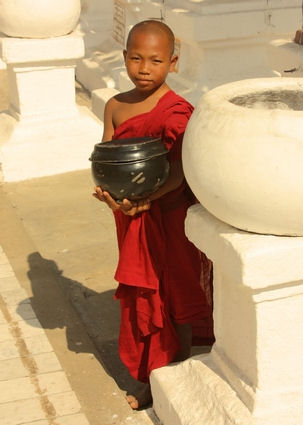 73. A novice monk with his alms bowl of the kind seen in paintings above. The design has not changed for centuries. |
74. Large bells for the faithful to ring to proclaim they have made merit. |
75. Statue of Buddha instructing his followers. |
76. Nats guard the staircase |
77. Nats stand guard on the corners |
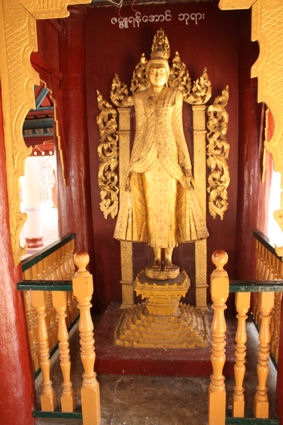 78. Lovely large statue of Buddha |
79. Nats and Hindu gods decorate the corners of the buildings. |
80. You can buy strings of the fragrant jasmine flower. |
81. Before we leave, we make merit by offering our flowers to the Buddha. |
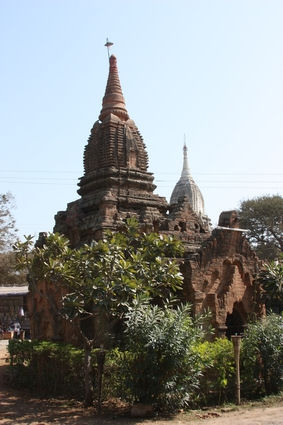 82 |
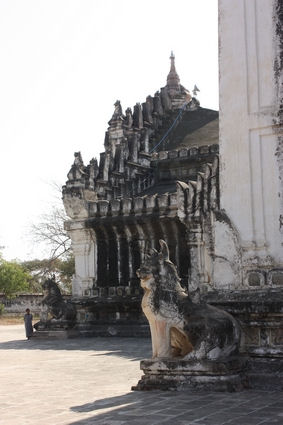 83 |
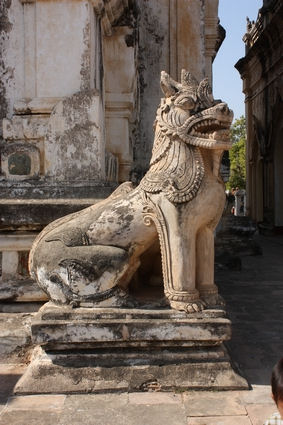 84 A lion sits on each corner of the building |
85 |
One thing which is unique about this temple is that it was built in the shape of a cross with spires that have recently been coated with gold leaf. Each wing contains a gold leaf covered 31 foot statue of the Buddha facing one of the cardinal directions: N, E, S, and W. Each statue, carved from the trunk of a Teak tree, displays a different facial expression. As you may recall, the way in which the Buddha holds his hands signifies one of his lessons.
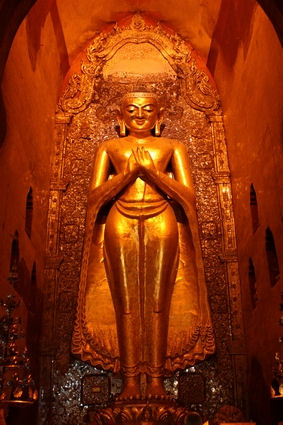 86 South Facing |
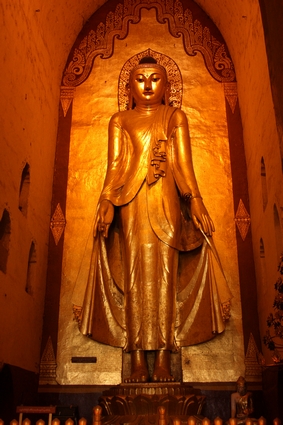 87 North Facing |
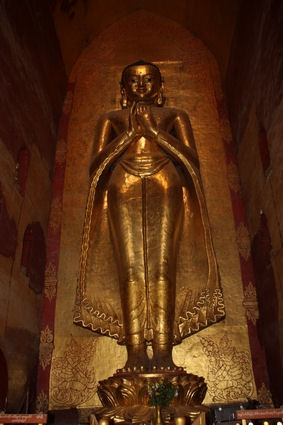 88 East Facing |
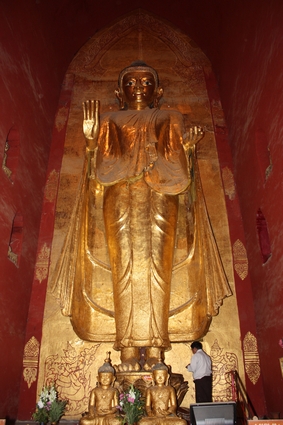 89 West Facing |
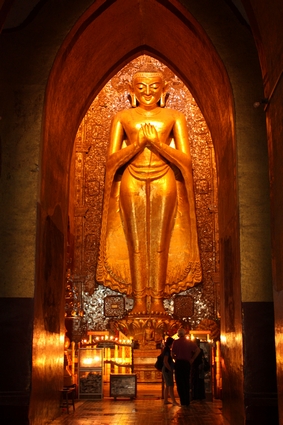 90 From a distance the Buddha's eyes are closed and he has a smile. |
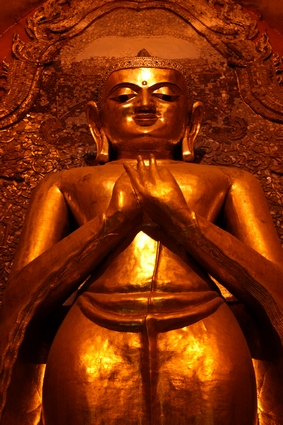 91 As you get closer his eyes open and he takes on a more serious look. |
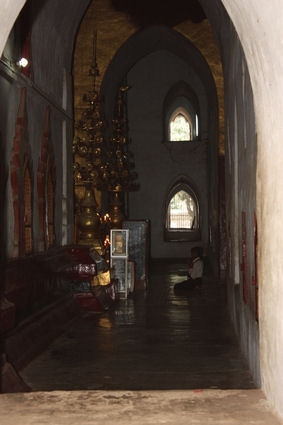 92 The long corridors between the wings contain plaques depicting the Buddha's life |
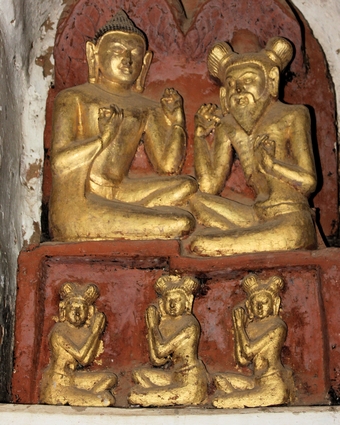 93 The Buddha is tempted by the Devil who offers him maidens. Naturally, the Buddha declines the offer. |
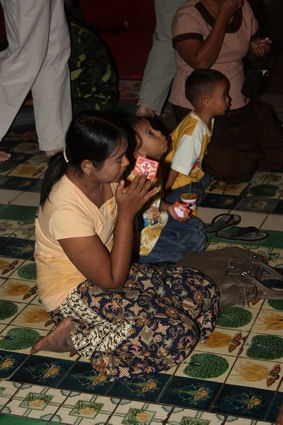 94 Family pay homage to the Buddha |
95 A woman is set up outside the temple to serve lunch to hungry pilgrims. |

96 Our hotel in Bagan |
97 The swimming pool looks inviting. |
98 The moon starts its path across the sun |
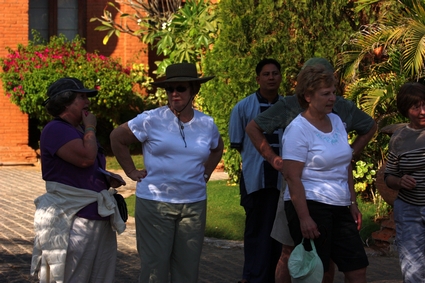 99 The sky darkens as the sun is covered |
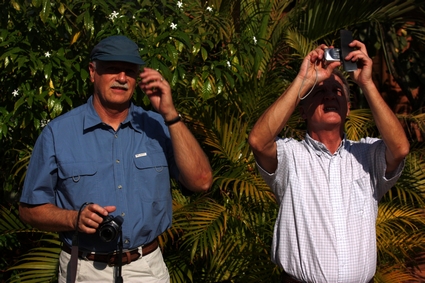 100 The hotel staff shares their smoked glass so we can see the eclipse |
101 An annular eclipse takes place when the moon is not large enough to cover the whole sun as it does during a total eclipse. |
102. Bamboo shoots can easily be cut into long thin strips which can then be bent around any frame to make a bowl or other shape. |
103. Bamboo is the perfect product to make almost anything. It grows abundantly everywhere and is cheap, it is strong, bends into almost any shape and holds up against moisture. |
104. Framing a bowl from bamboo |
105. Bowls or cups or vases are covered with the black cement and then sanded down so the shiny black lacquar can be applied in several coats. |
106. Everything is done by hand. Tops for bowls are cut on a hand operated lathe. |
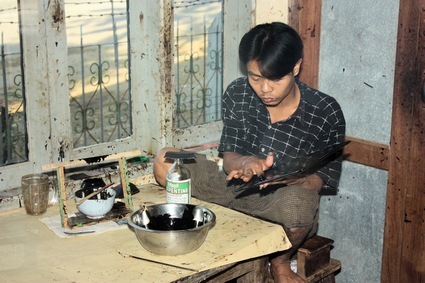 107 Several coats of black lacquar are applied. |
108 Using a stylus designs are etched into the surface. |
109 After the lacquar has dried then the real artisans take over. |
110 After the etching color is rubbed onto the surface but it only adheres to the rough etched designs. If a second color is desired then more etching takes place and the color is applied. |
111 Very lovely finished products boxes to hold jewelry, coasters for your soft drinks, trays to display your nail polish, or it can be hung on the wall as a piece of art. |
112 Once we have toured the factory we are shown the many lovely finished products are for sale. |
113 We are treated like royalty with hot tea and spiced peanuts. |
After we made our purchases we discovered that many of the same products are for sale on the street by young girls at a fraction of the cost (after a sufficient time spent haggling over the price of course). I wondered how the kids on the street were able to sell the product at such a reduced price. When we got back to our hotel - and sometimes back home - we discovered that the items we bought on the street had small flaws in the design or lacquar coating and would be considered "seconds" in a factory store. I speculate the factory makes these available to the young kids so they can earn some cash for the family. To my way of thinking this is not such a bad idea. So my "tip for today" is, if you are looking for something really nice, get it at the factory where you can inspect it in the light. When buying some small gift to give away when you get home the street product is a really great buy. You will have a beautiful item and the fun of bragging about how you got that 12 year old girl to come down from $50 to $3.00 for a set of 6 coasters. To be honest, at a $3.00 they would be a great buy at twice the price. Remember, you are traveling for the memories and every time you see the lacquarware in your home you will think about your trip to Myanmar. Indulge yourself, have fun and take home some memories.

![]()
Sulamani Pagoda and Sunset
.After visiting the Lacquarware factory we headed for the Sulamani Temple. We are now appreciating why Bagan got its nickname as the "City of a Million Pagodas".
114 We travel by air conditioned bus. |
115 Local travel is quite different. |
116 Sometimes traffic is slowed by obsticals on the road. Most roads are dusty dirt paths through the fields. |
117 Bicycles are a common form of travel. |
118 The Sulamani Pagoda is famous for its Jataka stories painted on the walls. |
119 Remove your shoes and socks really means going barefoot. |
120 Vendors set up shops |
121 A treasure for every taste: Confucius, Buddha, and Hindu, Everyone is welcome. |
122 An ogre checks out every visitor |
123 Gold covered Buddha |
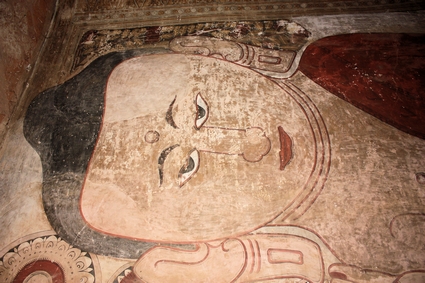 124 Like stained glass windows in a Christian church, wall paintings, going back to the 12th century, tell about the life of Buddha. This is the reclining Buddha. |
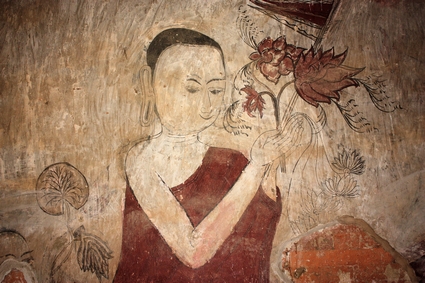 125 |
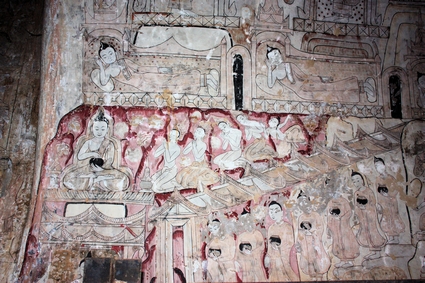 126 So many wonderful stories and they are so foreign to us. |
127 Is it any wonder that I wanted to learn more when I returned home? |
128 The corridors are three stories high full of paintings |
129 An ornate gate protects one entry. |
129 We board a different form of transportation. |
130 We are headed to the Pyathatgyi pagoda to watch the sun set |
131 The roads are very dusty as we race to our destination. |
132 We must hurry, the sun is starting to set. |
133 We arrive with little time to spare. |
134 We have to move quickly upstairs to the roof. |
We climb many steps to get to the roof. |
The local farmers have seen it all before. They are interested in getting their cattle home. |
135 A beautiful red sunset is already in progress |
136 Like watching the sunset on a beach, everyone's attention is facing west. |
137 Some find a comfortable roof ledge. |
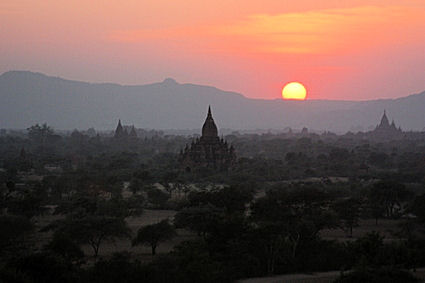 138 No matter where you are, the scene is stunning. Click, click, click, click goes my camera shutter. How many pictures do you need to see? |
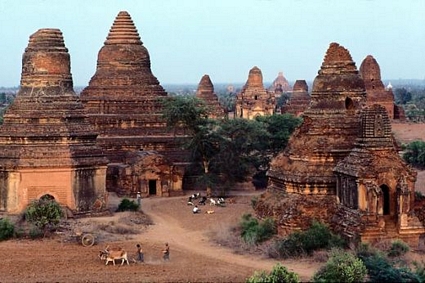 141 A picture I wish I had taken. I copied it out of a book to show you how beautiful it is. You can tell the picture was taken toward the start of the rainy season because the farmer is plowing the field with his ox. |
142 It was dark as we decended the staircase. Note the candles on the stairs to provide some light. My camera flash makes it look a lot lighter than it really was. Look at how dark it is behind Fran. Our hands were on the ceiling because it was so dark we would bump our heads on the vault of the short ceiling. |
143 The day is drawing to a close and we go to the Green Elephant for dinner |
144 We eat on the lawn and our dinner is delivered on unique hand carts. |

Lets go to Day 2 in Bagan (yet to be constructed )
Lets go to Madalay (yet to be constructed )

Write to![]() Belli for more information about our travels .
Belli for more information about our travels .
